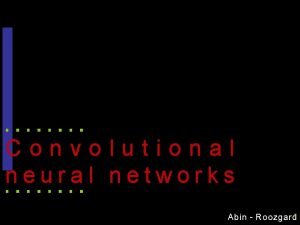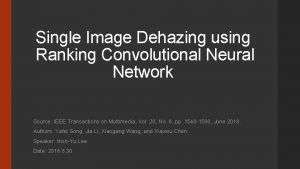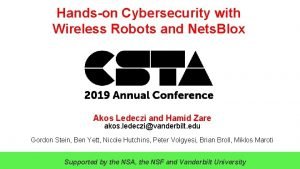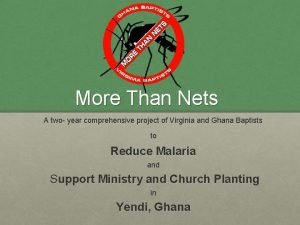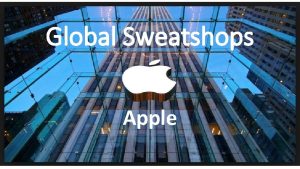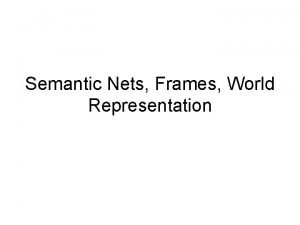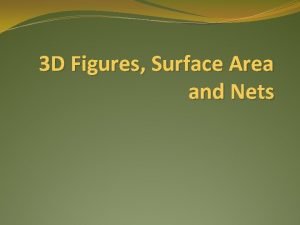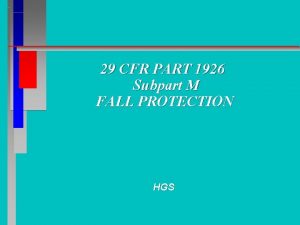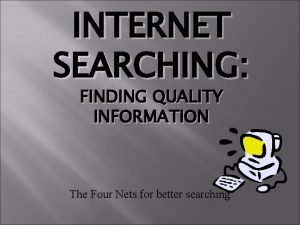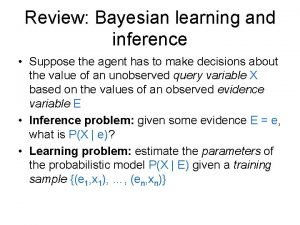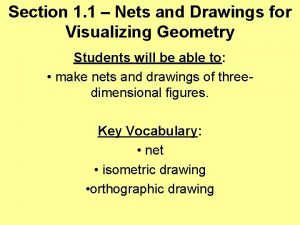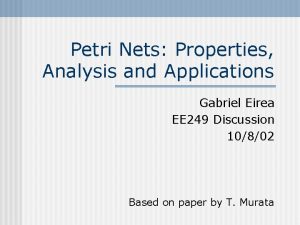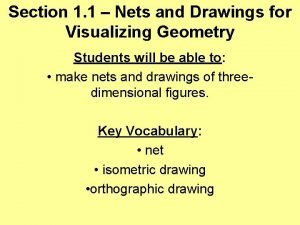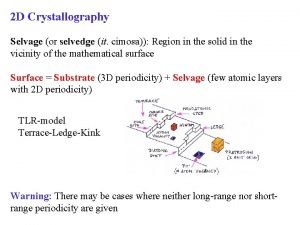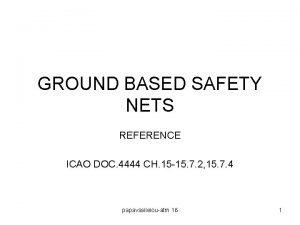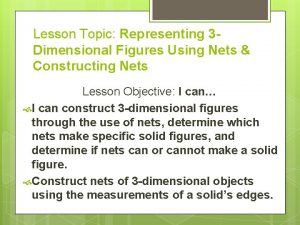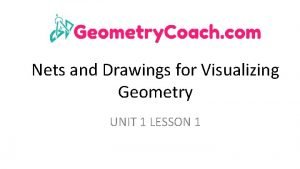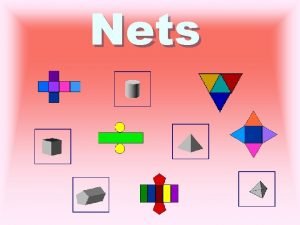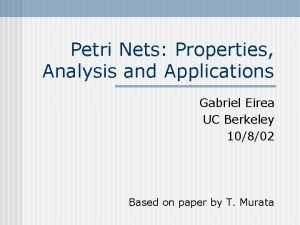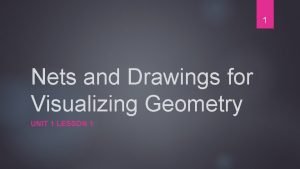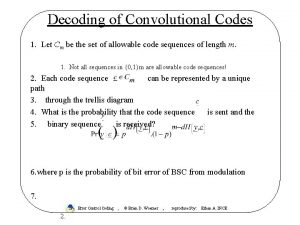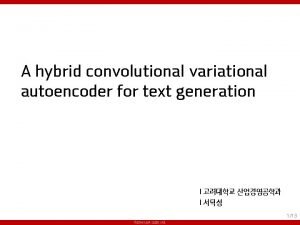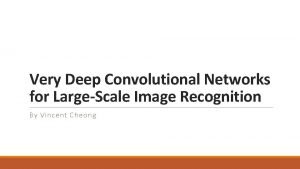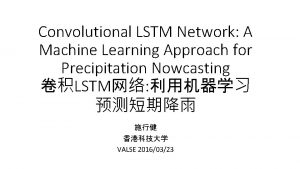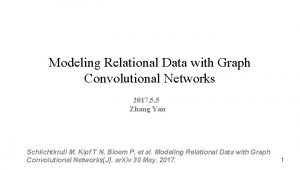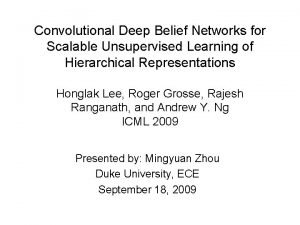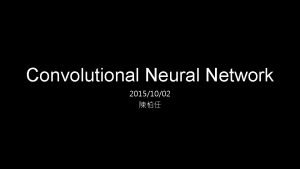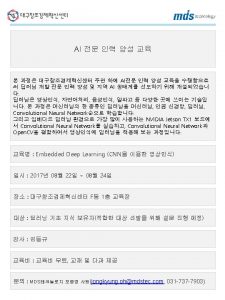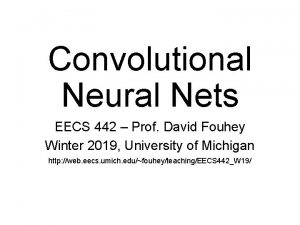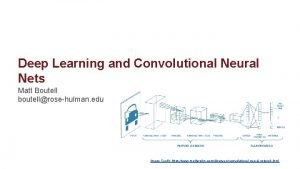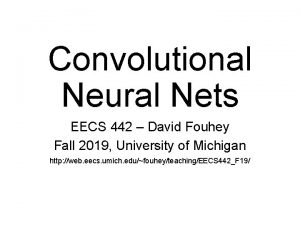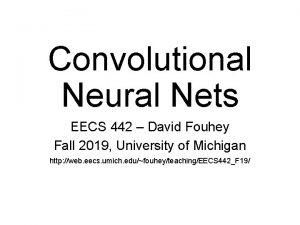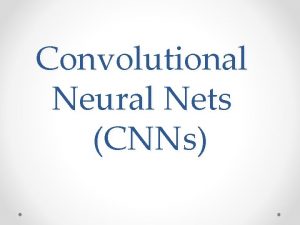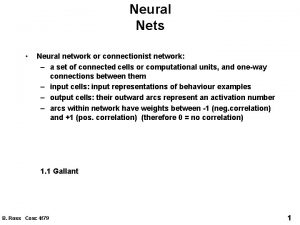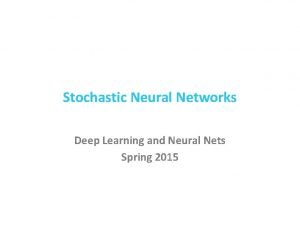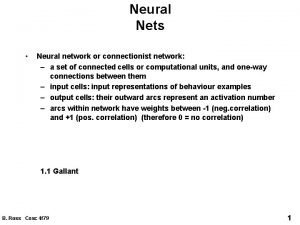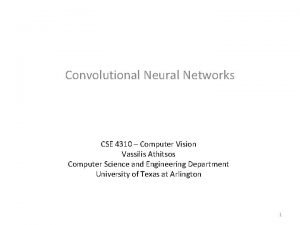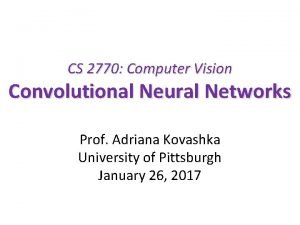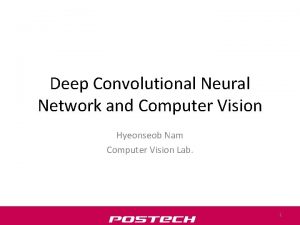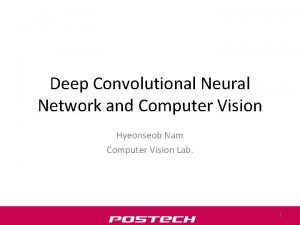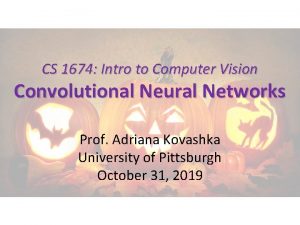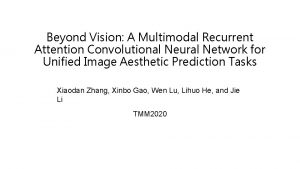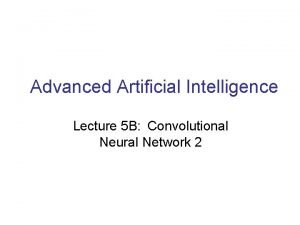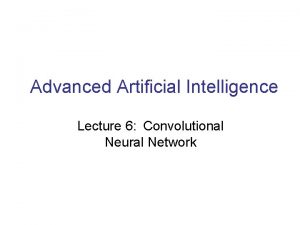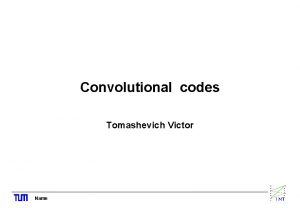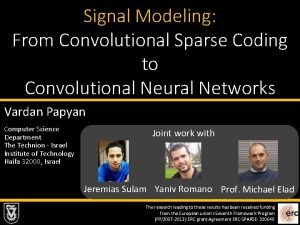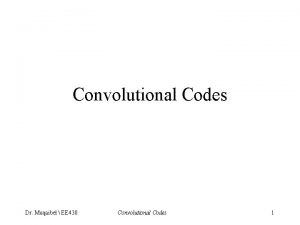Convolutional Neural Nets Advanced Vision Seminar April 19






































- Slides: 38

Convolutional Neural Nets Advanced Vision Seminar April 19, 2015

Overview • The Revolution(2012) : Image. Net Classification with Deep Conv. Nets – Large performance gap – Possible Explanations • What makes convnets tick? Visualizing and Understanding Deep Conv. Nets • Some Limits of conv. Nets • Useful Resources

Image. Net Classification with Deep Conv. Neural Networks • Until 2012: Leading methods used hand-crafted features + encoding methods (e. g, SIFT+Bag-of. Words+SVM) • NIPS 2012, Alex Krizhevsky et. Al • Significant improvement w. r. t other methods: Image. Net performance – 2010: ~28% (pre-convnet) – 2012: 16% (Krizhevsky) – 2013: 12% – 2014: 6. 7%

Causes for Performance Gap: • Deep Nets have been around for a long time, why the sudden gap? • Combination of multiple factors: – Network Design – Scale of Data – Re. Lu faster convergence – Dropout – less overfitting – SGD – GPU computations

Network Design • Basic layer types: – Convolution – Nonlinearity – Pooling : max, avg – Local Normalization Lecun, 1989 • 8 Layers (deeper, wider than 1989) connected can also be viewed as convolution, receptive field is entire layer Krizhevsky, 2012

Network Design (Layer 0): Input : 224 x 3 mean-subtracted Layer 1: 96 kernels of 11 x 3, stride of 4 pixels, max pool and locally normalize Layer 2: 256 kernels of 5 x 5 x 96, max pool Layers 3 -5: more convolutions, similar to 1, 2 Layers 6, 7 : fully connected, 4096 hidden units each Layer 8: Soft-max over 1000 classes ….

Num Samples vs. Num. Parameters • The network has ~60, 000 parameters. To avoid overfitting, a lot of data is needed • Imagenet is indeed very large: > millions images – Training set: 1. 2 mil. Images, 1000 obj. classes • Additional samples are generated via data augmentation: simple geometric and color transformations • Dropout

Optimization - definitions Loss on one sample (softmax-loss) D – Data/Batch size : “Momentum Variable” (update history) Loss on batch : Regularization term : : Learning rate Momentum improves convergence stability and speed • Regularization term crucial for performance, according to authors • •

Optimization • • Set =. 9, = 0. 0005 , D=128 (batch size) Num. Epochs: 90 Update: =. 001 (initially) • This is called SGD+Momentum

Relu: Faster Convergence • Nonlinearity: tanh-> Relu (rectilinear unit) • Easier to differentiate • Avoids saturation • In practice, much faster convergence Krizhevsky, 2012 Relu Tanh

Stronger Machines • Modern GPU architectures enable massively parallel computations of the sort required by deep conv. nets • Training with two strong GPU’s, this took “only” 6 days – a x 50 speedup w. r. t to CPU training

Imagenet Results • LSVRC : Large Scale Visual Recognition Challenge • Imagenet (2014): 1. 4 mil. Images, 1000 obj. classes • Compare: Pascal : 22, 000 images, 20 obj. classes)

Results - 2012 Agaric

Generic Use in Vision • Using the output of the fully connected layers as a generic feature extractor has proven to very strong • Beating state of the art in many datasets/benchmarks unrelated to Image. Net • This is now standard in object detection, scene classification, Scene parsing, Segmentation, and many more • “Machine crafted” vs. hand crafted features

Generic Use in Vision a computer vision scientist: How long does it take to train these generic features on Image. Net? Hossein: 2 weeks Ali: almost 3 weeks depending on the hardware the computer vision scientist: hmmmm. . . Stefan: Well, you have to compare three weeks to the last 40 years of computer vision *quote from http: //www. csc. kth. se/cvap/cvg/DL/ots/ A. S. Razavian, H. Azizpour, J. Sullivan, S. Carlsson "CNN features off-the-shelf: An astounding baseline for recognition", CVPR 2014, Deep. Vision workshop

Network Design ? ? • How to determine “hyper-parameters”: – No. layers? – Kernel Size/Num. of kernels? – Training rate? Number of training epochs? –… • From own experience, either: – Start with existing network & tweak / finetune – Incrementally increase network complexity – start with a few layers, see what works • Domain knowledge : convolutions are especially suited for images, not always the right choice

Network Structure • (To my knowledge) no rigorous analysis of effect of network structure, either theoretical or empirical – Example: systematically check many different network structures / configurations – See what works well, what doesn’t and explain why • Guessing: Probably done by successful architectures, but “bad” results not published

Visualizing & Understanding Conv. Nets What Makes Convnets “Tick”? What happens in hidden units? Layer 1: easy to visualize Deeper layers: just a bunch of numbers? Or something more meaningful? • Do convnets use context or actually model target classes • •

Introducing: Visualizing & Understanding Conv. Nets • Zeiler & Fergus, 2013 • Goal: Try to visualize the “black box” hidden units, gain insights • Hope: Use conclusions to improve performance • Idea: “Deconvolutional” neural net

Deconvolutional Nets • Originally suggested for unsupervised feature learning : construct a convolutional net, cost function is image reconstruction error • Used here to find what stimuli causes strongest responses in hidden units • Run many images through net find strongest unit activations in each layer visualize by “reversing” net operation

Reversing a convent

“Unpooling”

Deconvolution* • Want to visualize a strong activation in feature map P from layer L+1 down to layer L. • As in Deep-Belief Nets: L P*F’, where F’ is the original kernel flipped in both dimensions • Intuition: can show, gradient of F w. r. t input is F’, this is back-propping error of strongest activations • *Note: Not really “deconvolution”, this is not an attempt to recover original signal

Layer 1:

Hidden Layer Visualizations: layer 2

Hidden Layer Visualizations: Layer 3

Hidden Layer Visualizations: Layer 4

Hidden Layer Visualizations: Layer 5

It’s Nice to Watch, But is it Useful? • Authors observed aliasing effects caused by large stride in lower layers (e. g, loss of fine texture) • Reducing filter size and stride increased performance, also reporting qualitatively “cleaner” looking filters

Is the net using context? • Let’s test if the network really focuses on relevant features • Systematically occlude different parts of image • Check output confidence for true class • (This doesn’t really have to do with the visualization)



Following Network paths • B. Zhou et al , Object Detectors Emerge in Deep CNNs, ICLR 2015

Going Deeper with convolutions • Recently, even deeper models have been proposed: Goog. Le. Net – 22 layers : 6. 7 top 5 error • 16 and 19 layer architectures from VGG , similar performance

Limits : Easy Classes : natural, highly textured, fine-grained • Natural, Highly textured, fine-grained

Limits : Difficult Classes • Man-Made, simple, non-textured, functional ?

Useful Tools • For starters: Mat. Conv. Net : – – Matlab Simple, straightforward Pre-trained popular models Windows/Linux compatible • More advanced: Caffe : – Powerful , open-source framework for training and testing convnets, with c++/python/matlab interfaces – Mostly Linux (some old windows ports) – “Model-Zoo” : updates often with state-of-the-art models • Many more deeplearning. net/software_links/

Thank You • References: • Lecun et al, Backpropagation Applied to Handwritten Zip Code Recognition (MIT press, 1989) • Zeiler et al, Visualizing and understanding convolutional networks, ECCV 14 • Rob Fergus. Deep Learning for Computer Vision (Tutorial). NIPS, 2013 (including several imgs from slides) • Russakovsky et al, Image. Net Large Scale Visual Recognition Challenge. ar. Xiv: 1409. 0575, 2014 • A. S. Razavian, H. Azizpour, J. Sullivan, S. Carlsson "CNN features off-the-shelf: An astounding baseline for recognition", CVPR 2014, Deep. Vision workshop
 Sparse convolutional neural networks
Sparse convolutional neural networks Convolutional neural networks
Convolutional neural networks Image style transfer using convolutional neural networks
Image style transfer using convolutional neural networks Convolutional neural network
Convolutional neural network Convolutional neural network
Convolutional neural network Xooutput
Xooutput Visualizing and understanding convolutional networks
Visualizing and understanding convolutional networks Convolutional neural network alternatives
Convolutional neural network alternatives Convolutional neural networks
Convolutional neural networks Convolutional neural networks for visual recognition
Convolutional neural networks for visual recognition Partitioned semantic nets in artificial intelligence
Partitioned semantic nets in artificial intelligence Nets blox
Nets blox Nets church planting
Nets church planting Apple sweatshop nets
Apple sweatshop nets Semantic nets and frames
Semantic nets and frames Surface area using nets
Surface area using nets 29 cfr 1926 subpart m
29 cfr 1926 subpart m List the 4 nets for better internet searching
List the 4 nets for better internet searching For better convenience
For better convenience Bayes nets
Bayes nets Nets and drawings for visualizing geometry
Nets and drawings for visualizing geometry Petri nets properties analysis and applications
Petri nets properties analysis and applications Nets and drawings for visualizing geometry
Nets and drawings for visualizing geometry Crystallography
Crystallography Stca aviation
Stca aviation Represent solid figures using nets
Represent solid figures using nets Nets and drawings for visualizing geometry
Nets and drawings for visualizing geometry Nets of square pyramid
Nets of square pyramid Semantic nets
Semantic nets Gabriel y petri
Gabriel y petri Nets and drawing for visualizing geometry
Nets and drawing for visualizing geometry Structured light
Structured light Convolutional codes solved examples
Convolutional codes solved examples Convolutional transpose
Convolutional transpose Deep convolutional networks
Deep convolutional networks Fc-lstm
Fc-lstm Convolutional sequence to sequence learning
Convolutional sequence to sequence learning Modeling relational data with graph convolutional networks
Modeling relational data with graph convolutional networks Convolutional deep belief networks
Convolutional deep belief networks

